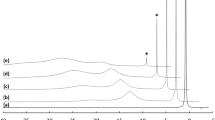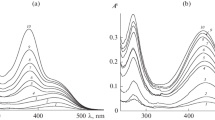Abstract
In dilute aqueous solutions, at pH values below 3.5, aluminium salts dissolve to yield a triply-charged positive ion which interacts with solvent water to form the species [Al(H2O)6]3+, frequently written as Al3+. At physiological pH (7.4) in aqueous solution and in the absence of potential ligands other than water, the coordinated water molecules lose protons leading to the hydrolysed species [Al(OH)4]-, an aluminium ion tetrahedrally surrounded with four OH- groups. At intermediate pH values the species [Al(H2O)5(OH)]2+, [Al(H2O)4(OH)2]+ and [Al(OH)3] coexist. The exact proportions of each, which depend on the pH value of the solution, can in principle be calculated from their known stability constants [1]. However, at concentrations of Al3+ > 1 µM the low solubility of [Al(OH)3] in its amorphous form or as Gibbsite may be important.
Access this chapter
Tax calculation will be finalised at checkout
Purchases are for personal use only
Preview
Unable to display preview. Download preview PDF.
Similar content being viewed by others
References
Martell AE and Smith TM, 1974-77: ‘Critical Stability Constants’, Plenum Press, New York, Vol. 1-5.
Diebler H, Eigen M, Ilgenfritz G, Maas G and Winkler R, 1969: Kinetics and mechanism of reaction of main group metal ions with biological carriers. Pure Appl Chem 20: 93.
Foy CD, Burns GR, Brown JC and Fleming AL, 1965: Differential aluminum tolerance of two wheat varieties associated with plant induced pH changes around their roots. Soil Sei Soc Am Proc 29: 64.
Rhue RD and Grogan CO, 1977: Screening of corn for Al tolerance using different Ca and Mg concentrations. Agron J 69: 755.
Horst WJ, Wagner A and Marschner H, 1983: Effect of aluminium on root growth, cell division rate and mineral elements in roots of Vigna unguiculata genotypes. Z Pflanzenphysiol 109: S95.
Siegel N and Haug A, 1983: Calmodulin-dependent formation of membrane potential in barley root plasma membrane vesicles: a biochemical model of aluminium toxicity in plants. Physiol Plant 59: 285.
Driscoll CT, Baker JP, Bisogni JJ and Schofield CL, 1980: Effect of aluminium speciation on fish in dilute acidified waters. Nature 284: 161.
Cochran M, Patterson D, Coates JH and Coates PTH, 1984: Protein binding of aluminium in plasma of maintenance haemodialysis patients. Trace element analytical chemistry in medicine and biology. Vol. 3 pp. 311–318. Ed. P. Bratter, P. Schramel, Walter de Gruyter & Co., Berlin, New York.
Cheung WY, 1980: Calmodulin plays a pivotal role in cellular regulation. Science 207: 19.
Klee CB, Crouch TH and Richman PG, 1980: Calmodulin. Ann Rev Biochem 49: 489.
Dedman JR, Potter JD, Jackson RI, Johnson JD and Mean AR, 1977: Biological cross- reactivity of rat testis phosphodiesterase activator protein and rabbit skeletal muscle troponin-C. J Biol Chem 252: 8415.
Siegel N and Haug A, 1983: Aluminium interaction with calmodulin: Evidence of altered structure and function from optical and enzymatic studies. Biochem Biophys Acta 744: 35.
Haug A and Weis C, 1986: Aluminium-induced changes in calmodulin. In: Molecular and cellular aspects of calcium in plant development. Ed. A. J. Trewazas. NATO ASI Series: Life Sciences, Vol. 104. Plenum Press, New York and London.
Nishizuka Y, 1984: The role of protein kinase C in cell surface signal transduction and tumour promotion. Nature 308: 693.
Elliott DC and Skinner JD, 1986: Calcium-dependent, phospholipid-activated protein kinase in plants. Phytochem 25: 39.
Wolf M, LeVine H, May WS, Cuatrecasas P and Sahyoun N, 1985: A model for intracellular translocation of protein kinase C involving synergism between Ca2+ and phorbol esters. Nature 317: 546.
De Boni U, Scott JW and Crapper DR, 1974: Intracellular aluminum binding. A histochemical study. Histochem 40: 31.
Fleming J and Joshi JG (1987) Ferritin: Isolation of aluminum-ferritin complex from brain. Proc Natl Acad Sei USA 84: 7866.
Karlik, SJ, Eichhorn GL, Lewis PN and Crapper DR, 1980: Interaction of aluminum species with DNA. Biochem 19: 5991.
Matsumoto H, 1988: Changes of the structure of pea chromatin by aluminum. Plant Cell Physiol 29 (2): 281.
Van Berkum MF, Wong YL, Lewis PN and Crapper McLachlan DR, 1986: Total and poly ( A) RNA yields during an aluminum encephalopathy in rabbit brains. Neurochem Res 11: 1347.
Trapp GA, 1983: Plasma aluminum is bound to transferrin. Life Sciences 33: 311.
Rahman H, Skillen AW, Channon SM, Ward MK and Kerr DNS, 1985: Methods for studying the binding of aluminum by serum protein. Clin Chem 31: 1969.
Cochran M, Patterson D, Neoh S, Stevens B and Mazzachi R, 1985: Binding of Al by protein in plasma of patients on maintenance hemodialysis. Clin Chem 31: 1314.
Beguin Y, Huebers H and Finch CA, 1988: Random distribution of iron among the two binding sites of transferrin. Clin Chim Acta 173: 299.
Cochran M, Cochran M, Coates JH, and Kurucsev T, 1987: Direct spectrophotometric determination of the two site binding of aluminum to transferrin. Life Sciences 40: 2337.
Rahman H, Channon SM, Skillen AW, Ward MK and Kerr DNS, 1985: Aluminium transfer during hemodialysis and its relation to serum ultrafiltrable aluminium. Trace elements in medicine 2: 143.
Burnatatowska-Hledin MA, Mayor GH and Lau K, 1985: Renal handling of aluminum in the rat: clearance and micropuncture studies. Am J Physiol 249: F192.
Harrison PM, Banyard SH, Hoare RJ, Russell SM and Treffry A, 1977: Structure and function of ferritin. In: Iron Metabolism. Ciba Foundation Symposium 51 ( New Series). Elsevier. Excerpta Medica. New Holland. Amsterdam, Oxford and New York. pp. 19–40.
Price DJ and Joshi JG, 1983: Ferritin. Binding of beryllium and other divalent metal ions. J Biol Chem 258: 10873.
Price DJ and Joshi JG, 1982: Ferritin. A zinc detoxicant and zinc ion donor. Proc Natl Acad Sei USA 79: 3116.
Hummel JP and Dreyer WJ, 1962: Measurement of protein-binding by gel filtration. Biochim Biophys Acta 63: 530.
Mahler HR and Cordes EH, 1966: Biological Chemistry. Harper and Row. New York and London.
Banks WA and Kastin AJ, 1983: Aluminium increases permeability of the blood-brain barrier to labelled DSIP and ß-endorphin. Lancet, ii: 1227.
Lai JCK, Guest JF, Leung TKC, Lim L and Davison AN, 1980: Effects of cadmium, manganese, and aluminum on Na-K activated and Mg activated ATPase activity, and choline uptake in rat brain synaptosomes. Biochem Pharmacol 29: 141.
King RG, Sharp JA and Bowra ALA, 1983: The effects of Al3+, Cd2+ and Mn2+ on human erythrocyte choline transport. Biochem Pharmacol 32: 3611.
Deleers M, 1985: Cationic atmosphere and cation competition binding at negatively charged membranes. Pathological implications of aluminum. Res Commun Chem Path Pharmacol 49: 277.
Deleers M, Servais JP and Wülfert E, 1985: Micromolar concentrations of Al3+ induced phase-separation, aggregation and dye release in phosphatidylserine-containing lipid vesicles. Biochim Biophys Acta, 813: 195.
Deleers M, Servais JP and Wulfert E, 1986: Neurotoxic cations induce membrane rigidification and membrane fusion at micromolar concentrations. Biochim Biophys Acta 855: 271.
Nir S, Diizgiines N, and Bentz J, 1983: Binding of monovalent cations to phosphatidylserine and modulation of Ca2+ and Mg2+ induced vesicle fusion. Biochim Biophys Acta 735: 160.
Papahadjopoulos D, Portis A and Pangborn W, 1978: Calcium-induced lipid phase transitions and membrane fusion. Ann NY Acad Sci 308: 50.
Martin RB, 1986: The chemistry of aluminum as related to biology and medicine. Clin Chem 32: 1797.
Koenig ML and Jope RS, 1987: Aluminum inhibits the fast phase of voltage-dependent calcium influx into synaptosomes. J Neurochem 49: 316 - 320.
Dill ET, Holden MJ and Colombini M, 1987: Voltage gating in VDAC is markedly inhibited by micromolar quantities of aluminum. J Membrane Biol 99: 187.
Karlik SJ, Elgarvish GA and Eichhorn GL, 1983: Multinuclear NMR studies on Alm complexes of ATP and related compounds. J Am Chem Soc 105: 602.
Lieberherr M, Grosse B, Cournot-Witmer G, Thil CL and Balsan S, 1982: In vitro effects of aluminium on bone phosphatases: A possible interaction with bPTH and vitamin D3 metabolites. Calif Tissue Int 34: 280.
Lai JCK and Blass JP, 1984: Inhibition of brain glycolysis by aluminum. J Neurochem 42 (2): 438.
Altmann P, Al-Salihi F, Butter K, Cutler P, Blair J, Leeming R, Cunningham J and Marsh F, 1987: Serum aluminum levels and erythrocyte dihydropteridine reductase activity in patients on hemodialysis. N Engl J Med 317: 80.
Cowburn JD and Blair J A, 1987: Effect of aluminium on in vitro tetrahydrobiopterin synthesis in brain preparations. Lancet ii: 105.
Macdonald TL, Humphreys WG and Martin RB, 1987: Promotion of tubulin assembly by aluminum ion in vitro. Science 236: 183.
Stryer L and Bourne HR, 1986: G-proteins: A family of signal transducers. Ann Rev Cell Biol 2: 391.
Michell R and Kirk C, 1986: G-protein control of inositol phosphate hydrolysis. Nature 323: 112.
Bourne HR, 1986: GTP-binding proteins: One molecular machine can transduce diverse signals. Nature 321: 814.
Sternweis PC and Gilman AG, 1982: Aluminum: A requirement for activation of the regulatory component of adenylate cyclase by fluoride. Proc Natl Acad Sci USA 79: 4888.
Blackmore PF, Bocckino SB, Waynick LE and Exton JH, 1985: Role of a guanine nucleotide-binding regulatory protein in the hydrolysis of hepatocyte phosphatidylinositol 4, 5-biphosphate by calcium-mobilizing hormones and the control of cell calcium: Studies utilizing aluminum fluoride. J Biol Chem 260: 14477.
Hughes BP and Barritt GJ, 1987: The stimulation by sodium fluoride of plasma-membrane Ca2+ inflow in isolated hepatocytes: Evidence that a GTP-binding regulatory protein is involved in the hormonal stimulation of Ca2+ inflow. Biochem J 245: 41.
Editor information
Editors and Affiliations
Rights and permissions
Copyright information
© 1990 Kluwer Academic Publishers
About this chapter
Cite this chapter
Cochran, M., Coates, J.H., Elliott, D.C. (1990). Aluminium interaction with macromolecules and membranes. In: de Broe, M.E., Coburn, J.W. (eds) Aluminum and renal failure. Developments in Nephrology, vol 26. Springer, Dordrecht. https://doi.org/10.1007/978-94-009-1868-9_10
Download citation
DOI: https://doi.org/10.1007/978-94-009-1868-9_10
Publisher Name: Springer, Dordrecht
Print ISBN: 978-94-010-7333-2
Online ISBN: 978-94-009-1868-9
eBook Packages: Springer Book Archive




